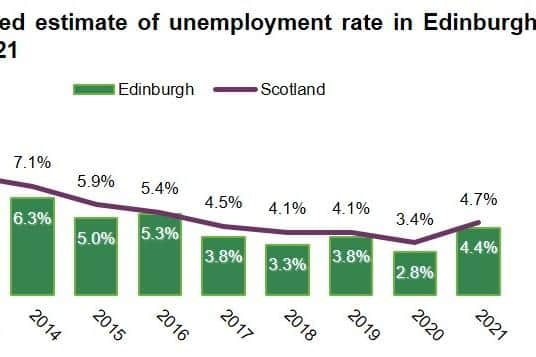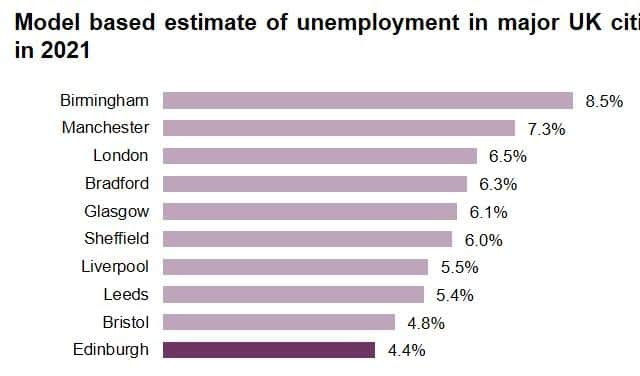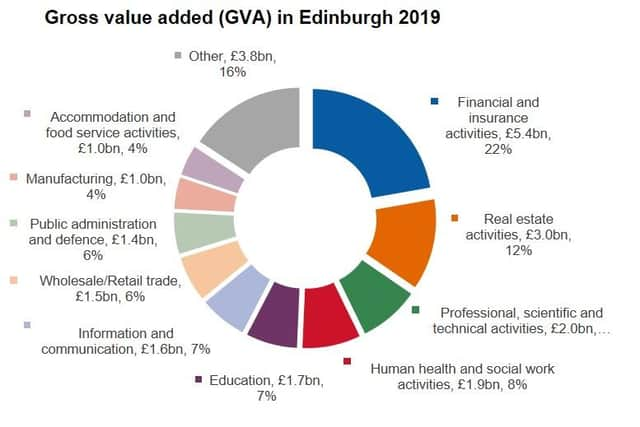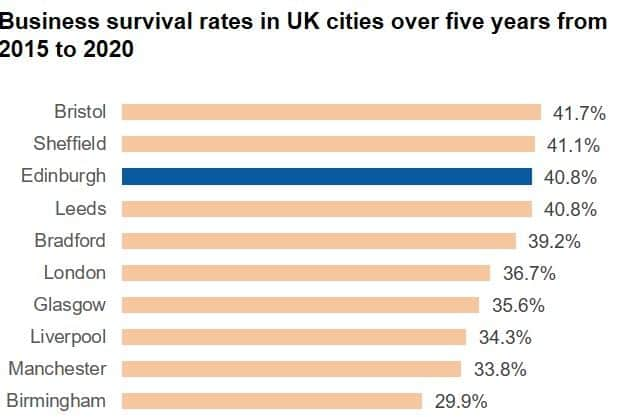Edinburgh's economy is looking good despite the pandemic, according to council data report
and live on Freeview channel 276
Let us know what you think and join the conversation at the bottom of this article.
The jobless rate for Edinburgh in 2021 was estimated at 4.4 per cent, compared with Birmingham at the top of the league on 8.5 per cent, Manchester on 7.3 per cent and London on 6.5 per cent, according to the council’s annual statistical overview Edinburgh by Numbers.
Meanwhile, only London was ahead of Edinburgh when it came to productivity per person, as measured by Gross Value Added (GVA) per head of population. London’s figure was £52,240, with Edinburgh next on £46,030, then Manchester on £44,352 and Glasgow on £35,032.


Advertisement
Hide AdAdvertisement
Hide AdFinance and insurance was the sector contributing most to the economy at £5.4 billion, 22 per cent of total GVA. Real estate activities were next with £3 billion; then professional, scientific and technical activities on £2 billion; and health and social work activities £1.9bn.
Education accounted for £1.7bn; information and communication £1.6bn; wholesale and retail trade £1.5bn; public administration and defence £1.4bn; manufacturing £1bn; and accommodation and food service activities £1bn.
The Capital also had the highest proportion of workers in high-skilled occupations of the nine largest cities outside London at 42.7 per cent of all workers, more than eight times the proportion of low-skilled occupations.
Council leader Adam McVey said the city had emerged from the pandemic with an economy which was still strong.


Advertisement
Hide AdAdvertisement
Hide AdHe said: “We need to remember Edinburgh is home now to real innovation, frontier industries, biomedical science, technology, robotics, fintech, as well as the major centres of the economy that are still here like the financial services industry.
“Edinburgh has weathered the storm quite well because we've continued to see that innovation and growth in key sectors, and even through Covid we’ve seen an increase in the film industry, more companies springing up, more people employed in the creative industries.
“So while Covid has been a dramatic challenge for all of us, the overall picture for Edinburgh is still enormously strong.”
But he said despite the encouraging figures there were “real challenges” too, particularly for the hospitality, retail and care sectors who were coping with the impact not only of Covid but also of Brexit and were finding it difficult to recruit staff.


Advertisement
Hide AdAdvertisement
Hide Ad“It is now getting to the point where it is fundamentally affecting their ability to function because they have seen running Covid absences at the same time as they are unable to fill vacancies, predominantly because of Brexit.”
He said there had to be a rethink on immigration policy. “We need additional people in some of these key sectors like care and hospitality. But until the UK Government is willing to look much more sensibly at visas, that situation is going to continue.”
Unemployment in the Capital has fluctuated over the last ten years, reaching a high of seven per cent in 2013, dropping to a low of 2.8 per cent by 2020 but increasing again by 2021 to 4.4 per cent.
A breakdown of employment shows health as the biggest sector in Edinburgh with 51,000 employees or 14.7 per cent of the total workforce. Business administration and support services is the next largest area for employment with 38,000 people or 11 per cent of the workforce, followed by financial services and education, which each have 33,000 employees or 9.5 per cent.


Advertisement
Hide AdAdvertisement
Hide AdAccommodation and food services accounted for 28,000 employees or 8.1 per cent of all jobs and retail had 26,000 employees and 7.5 per cent of jobs.
Average hourly pay rates in Edinburgh were the third highest out of the ten biggest cities – £15.64, behind London’s £18.67 and Bristol’s £15.84, but ahead of Glasgow’s £15.41.
Edinburgh’s average pay was at least £1 higher per hour than five other major UK cities.
But the report also notes that an estimated 15 per cent of workers in Edinburgh still earn less than the Scottish Living wage of £9.90 per hour.
Advertisement
Hide AdAdvertisement
Hide AdThe stats show Edinburgh with a business survival rate from 2015 to 2020 of 40.8 per cent, only exceeded by Bristol at 41.7 per cent and Sheffield at 41.1 per cent. Leeds was equal with Edinburgh, but the others all below 40 per cent, down to Birmingham on 29.9 per cent.


But Covid took its toll: in 2020 business deaths exceeded business births for the first time since 2009 by 2,715 to 2,235.
The report says: “The years 2011-2019 represented a period of growth in new businesses in Edinburgh, with business births consistently outstripping closures. However, as a likely impact of the pandemic in 2020, business deaths increased by 370 representing a 15.7 per cent increase compared to 2019. Despite a net decrease in business growth, over 40 per cent of Edinburgh businesses survived their first five years of operation.”
Figures for business density – the number of registered businesses per 1,000 residents – in major UK cities in 2020 put Edinburgh fifth in the table on 41.84, compared with top-placed London on 70.79 and bottom-of-the-table Sheffield on 31.15.
Advertisement
Hide AdAdvertisement
Hide AdEdinburgh had the highest proportion of its workforce educated to degree level or above at 62.1 per cent in 2020, followed by London at 59.3 per cent.
The Capital ranked second to Manchester in the number of students per 1,000 population with 129.2 against 170.9.
And Edinburgh also had a bigger proportion of overseas students in higher education than any of the other cities, with 10.7 per cent from the European Union – ahead of London on 9.5 per cent –and 24.1 per cent non-EU, just behind London’s 24.3 per cent.
A message from the Editor:
Thank you for reading this article. We're more reliant on your support than ever as the shift in consumer habits brought about by coronavirus impacts our advertisers.
If you haven't already, please consider supporting our trusted, fact-checked journalism by taking out a digital subscription.
Comment Guidelines
National World encourages reader discussion on our stories. User feedback, insights and back-and-forth exchanges add a rich layer of context to reporting. Please review our Community Guidelines before commenting.
